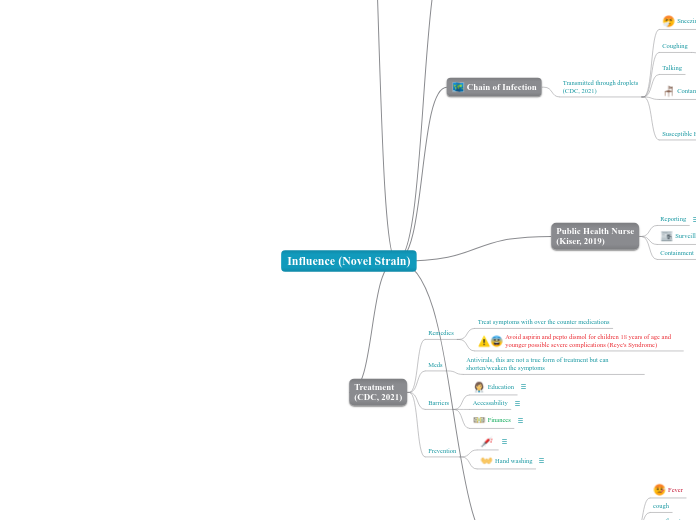Influence (Novel Strain)
Back Ground
(CDC, 2021)
Has believed to have been present for 6,000 years
First Isolated in Humans in 1933
Isolated by Christopher Andrews, Wilson Smith and Patrick Laidrow
Epidemiology
United States (%)
(South Dakota Department of Health, 2021)
0-4
5-17
18-49
50-64
65+
World Wide
(CDC, 2021)
Incidence
8.3%
Chain of Infection
Transmitted through droplets
(CDC, 2021)
Sneezing
Coughing
All 3 are the mode of transmission that moves the virus into another person mouth, eyes, or nose. Allowing the virus to enter another host
Covering nose and mouth with coughing or sneezing with help prevent the spread
Talking
Contaminated Surfaces
Its possible an individual can touch a surface with the virus present and then transmit it to themselves by touching their eyes, nose or mouth.
Susceptible Host
Although all of the previous items are present some individuals immune system is able to fight it off
If the body is unable to fight it off these individuals with have the virus
High Risk: weak immune systems due to age (young and old), chronic health conditions (such as diabetes, asthma, or heart disease), and pregnant woman
Public Health Nurse
(Kiser, 2019)
Reporting
Surveillance
Containment
Isolation
Treatment
(CDC, 2021)
Remedies
Treat symptoms with over the counter medications
Avoid aspirin and pepto dismol for children 18 years of age and younger possible severe complications (Reye's Syndrome)
Meds
Antivirals, this are not a true form of treatment but can shorten/weaken the symptoms
Barriers
Education
Accessability
Finances
Prevention
Hand washing
Pathophysiology
(CDC, 2021)
Symptoms
Fever
cough
sore throat
Runny/stuffy nose
Body aches
Including headaches
Fatigue
Can be due to vomiting or diarrhea this is seen more in children
Stages of Disease
Once exposed/infected symptoms typically show up 2 days later but can be anywhere from 1-4 days
Incubation Period
Individual are contagious for 3-4 days upon their illness beginning
Infection period can start one day prior to symptoms and last 5-7 days after
